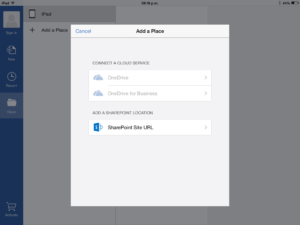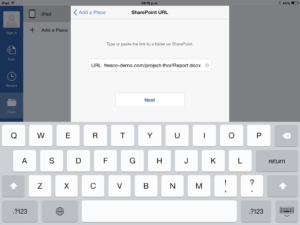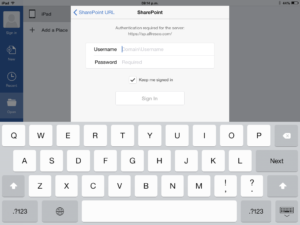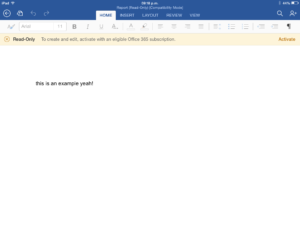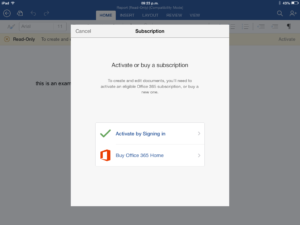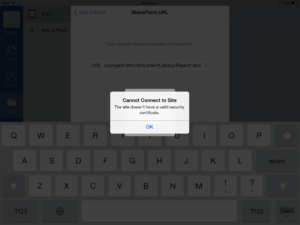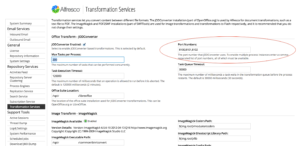Due to a conversation in Twitter with @binduwavell I haven’t found a single place where to find how to change any port related to all services that Alfresco runs. So, I have decided to write a blog post about it with some notes from Rich McKnight.
Here you go a comprehensive list of all ports and where to change them:
Tomcat:
- HTTP 8080: tomcat/conf/server.xml
- HTTPS 8443: tomcat/conf/server.xml
- Shutdown Port 8005: tomcat/conf/server.xml
- AJP 8009: tomcat/conf/server.xml
- JPDA 8000: catalina.sh
Alfresco:
Alfresco context inside Alfresco configuration: alfresco-global.properties
- alfresco.port=8080
Share:
Share context inside Alfresco configuration: alfresco-global.properties
- share.port=8080
If repository ports are changed you change Alfresco Share connection ports in web-extenxion/share-config-custom.xml
Alfresco SharePoint Protocol: alfresco-global.properties
- vti.server.port=7070
- vti.server.external.port=7070
OpenOffice – LibreOffice: alfresco-global.properties
- ooo.port=8100
JodConverter: alfresco-global.properties
- jodconverter.portNumbers=8100
FTP: alfresco-global.properties
Can be mapped to non-privileged ports, then use firewall rules to forward requests from the standard ports
- ftp.port=21
CIFS – SMB shared drive: alfresco-global.properties
Can be mapped to non-privileged ports, then use firewall rules to forward requests from the standard ports
- cifs.tcpipSMB.port=445
- cifs.netBIOSSMB.sessionPort=139
- cifs.netBIOSSMB.namePort=137
- cifs.netBIOSSMB.datagramPort=138
IMAP: alfresco-global.properties
Can be mapped to non-privileged ports, then use firewall rules to forward requests from the standard ports
- imap.server.port=143
Inbound Email (SMTP): alfresco-global.properties
Can be mapped to non-privileged ports, then use firewall rules to forward requests from the standard ports
- email.server.port=25
NFS server: alfresco-global.properties
Mount/NFS server ports, 0 will allocate next available port
- nfs.mountServerPort=0
- nfs.nfsServerPort=2049
RPC registration port, 0 will allocate next available port
Some portmapper/rpcbind services require a privileged port to be used
- nfs.rpcRegisterPort=0
To disable NFS and mount server registering with a portmapper set
- nfs.portMapperPort to -1
- nfs.portMapperPort=111
Cluster in 4.2 with Hazelcast: alfresco-global.properties
- alfresco.hazelcast.port=5701
Cluster in 4.1 with JGroups: alfresco-global.properties
- alfresco.tcp.start_port=7800
Solr:
From Solr to Alfresco workspace queries: ./alf_data/solr/workspace-SpacesStore/conf/solrcore.properties
- alfresco.port=8080
- alfresco.port.ssl=8443
From Solr to Alfresco archive queries: ./alf_data/solr/archive-SpacesStore/conf/solrcore.properties
- alfresco.port=8080
- alfresco.port.ssl=8443
From Alfresco to Solr queries: alfresco-global.properties
- solr.port=8080
- solr.port.ssl=8443
RMI service, JMX ports: alfresco-global.properties
- alfresco.rmi.services.port=50500
- avm.rmi.service.port=0
- avmsync.rmi.service.port=0
- attribute.rmi.service.port=0
- authentication.rmi.service.port=0
- repo.rmi.service.port=0
- action.rmi.service.port=0
- deployment.rmi.service.port=0
Monitoring RMI:
- monitor.rmi.service.port=50508
